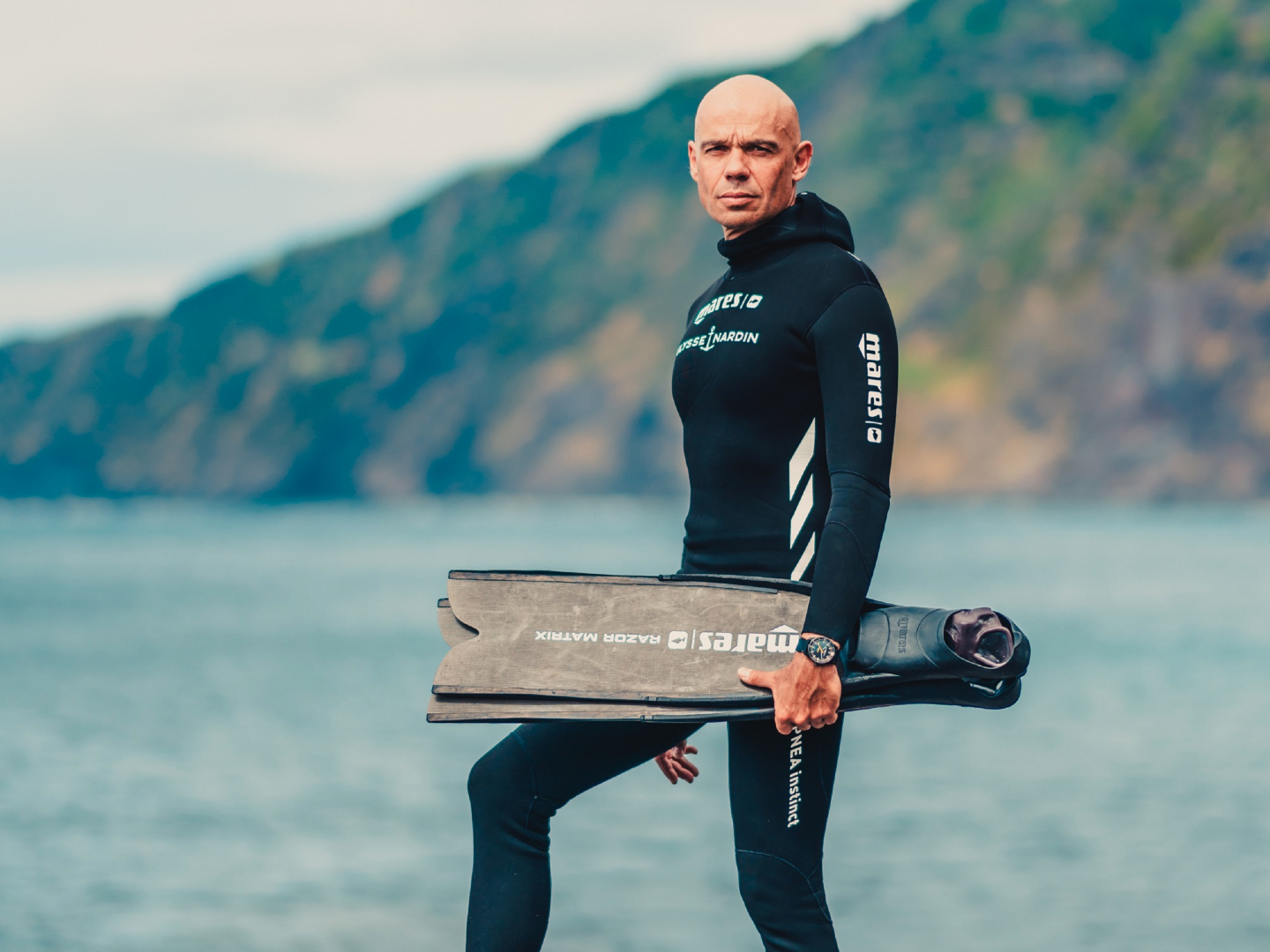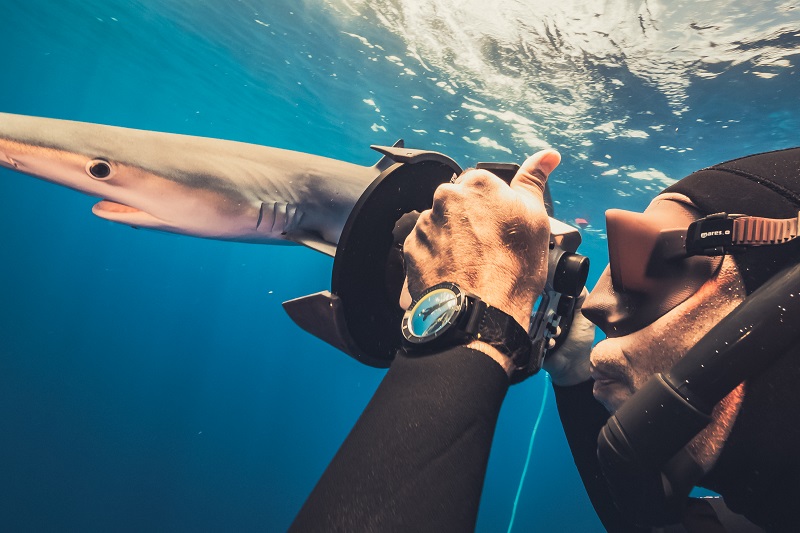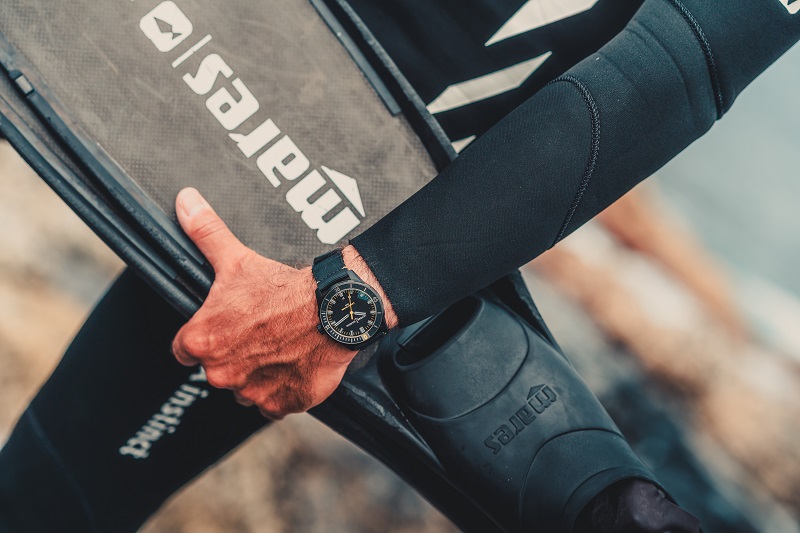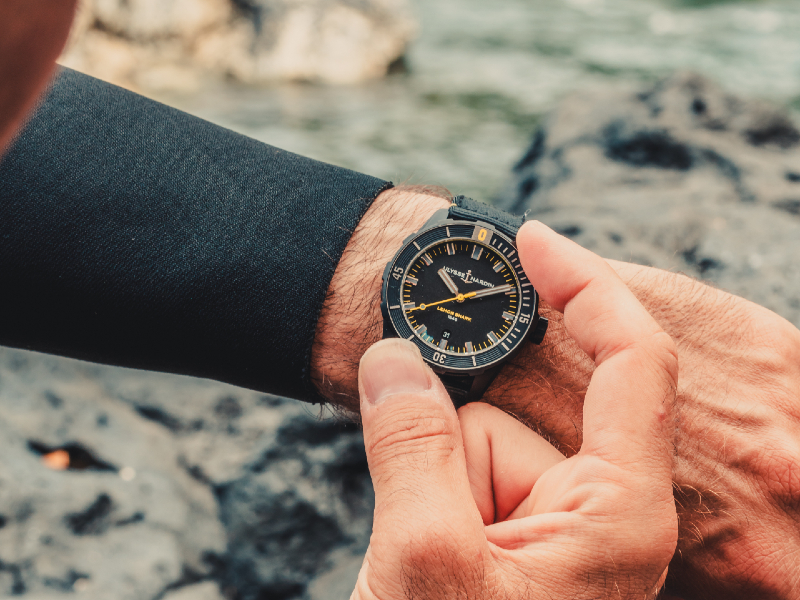
Expeditions take Buyle around the world but it is the Azores that he has returned to in between projects since 2012 (All photos: Ulysse Nardin)
What is breath? To most of us, it is the inhale that succeeds each exhale, a reflexive sequence that separates life from death. For Fred Buyle, it is the moment in which he leaves behind the world he was born into for the one he has dreamt about since he was knee-high.
Belgian-born Buyle grew up around the sea, spending significant parts of his childhood on sailboats his parents captained. While they occupied themselves with navigating the currents, he was far more fascinated by the dark depths and the life it concealed. He was learning to distinguish species of fish by age six or seven. Around eight, he put on a snorkel and was introduced to the underwater realm. At 10, he discovered freediving. There was no going back.
Freediving is how Buyle has experienced the richness of the world, from competing on global platforms for a decade — he set his first world record at age 23 in 1995 and went on to break two more — to facilitating his current occupation as an underwater photographer and marine life tagger. The first was an intentional pursuit into which he poured time and the boundless energy of youth; the last two happened rather serendipitously.
In 2002, he bought a camera to capture his peers in action but his incidental shots of marine life drew the attention of publications and the scientific community. When he retired from the competition circuit two years later, opportunities swiftly came knocking.
A lot can happen in the span of a breath. In 1999, Buyle passed the legendary 100m barrier on a single lungful of air, the eighth person in the world to do so. Fifteen years later, he would hold his breath as a sperm whale nudged her newborn calf his way, allowing for intimate photographs of a spectacular sight and one of the best moments of his life.
Freediving, photography and field work
It is 8am in the Azores, the picturesque archipelago of nine volcanic islands anchored in Macaronesia. Lonely Planet describes it as the “other Eden”, a paradise of basalt shores, verdant valleys and rocky outcrops with hot springs and waterfalls aplenty. The frothy waves of the surrounding North Atlantic Ocean are ripe for frolicking, and also home to and a transit point for a third of the world’s cetacean species. Sperm whales and dolphins live here year-round while blue whales are among the multitudes of marine life that seasonally swim by on their migration routes.
Of course Buyle would set up a base here.
Expeditions take him around the world but it is the Azores that he has returned to in between projects since 2012. In fact, some initiatives even involve the subaquatic creatures in his backyard.
behind_the_mask_64_1.jpg

“We’re currently studying blue sharks and mobula rays here with non-invasive tags,” says the tall and tanned Buyle over Zoom. “We freedive down to them and attach the tags by hand to record everything from their movement to ocean salinity and oxygen levels [oceanographers are now trying to track dead zones, areas of the ocean with low-oxygen or hypoxic conditions caused by pollution]. The tags detach after 24 hours and we recover them using radio beacons.”
Non-invasive tags have become a game changer, eliminating the need to catch and restrain marine animals to affix rigid attachments. This is where Buyle’s freediving proficiency comes in handy. Also known as skindiving, it relies on breath-holding until resurfacing rather than the use of breathing apparatuses.
“It is one of the most natural ways to explore the underwater world — all you need are a snorkel, mask and fins,” he says. In the case of this Ulysse Nardin ambassador, a diver’s watch is part of his regular minimalist get-up. Without the unwieldy bulk of oxygen tanks or other equipment, freedivers enjoy ease of movement that allows them to be one with the environment and to access more remote locations.
“Freediving photography produces very different results compared to photos taken by scuba divers. We don’t have to worry about decompression so we can move up and down as needed, which gives us immediate different perspectives. I also rely solely on natural light — I don’t use any flash or strobes — so the aesthetic is quite raw. When I started doing this, the shots were so distinct from your usual underwater photographs that magazines began contacting me about them.”
The wide angles and muted colours lend the photos a dreamy, almost ethereal quality that accurately reflects his view underwater. Hours upon hours spent in the water, first exploring its depths and his abilities in it and then building up encyclopaedic knowledge about its inhabitants, gave him the necessary confidence to move around and among shoals of marine life. This ease was crucial when he began aiding marine biologists in field work in 2005, using his freediving skills to perform acoustic or satellite tagging, DNA sampling or photography for documentation or studies.
Science and creativity are inextricably linked, he believes, and you need familiarity with both to get close to marine life or photograph them through a compelling storytelling lens. His is the fun part of the job, he laughingly admits.
“I come in when diving is needed, but that’s the easy bit. For me at least, perhaps not so much for the scientists,” he jokes. “They might not be as comfortable in the ocean, but their real work begins when the data has to be extracted, collated and analysed. These are projects that can run for years — tagging in the Azores has been going on since 2016, for instance, but it’s seasonal. Blue shark season here is from July to September, so there’s a short window for me to work within. In a year, I might be part of two to four projects.”
Such expeditions have whisked him from Portugal, France and the UK to the Philippines, Colombia and South Africa. Among his most interesting projects are the long-term shark studies with the gradual emergence of patterns and behaviours especially gratifying.
“You can really see how knowledge progresses from year to year,” he says. “I was part of a great white shark tagging expedition in Guadalupe in 2015, which had been ongoing for over a decade by then. I’m a tiny link in that chain, but when you step back and look at the big picture, the amount of data compiled and insights gained is astounding.”
Photography runs in his blood — his great-grandfather was a photography pioneer in the 1890s and his father had a stint snapping fashion — and his aptitude for it is highly in demand in furthering scientific understanding of marine life. An example is his work with Hvaldimir, an adult male beluga that wandered alone into the northern Norwegian fjord in 2019.
His sudden appearance was the subject of much debate as he was wearing a dorsal harness, which suggested he had escaped from a marine park or military facility. Fun fact: his name, a portmanteau of Hval (Norwegian for whale) and Vladimir (as in, Putin), came from the belief that he might have been a spy whale.
“After WWII, several navies, including the American and French, began training dolphins and whales to perform tasks because they’re clever and learn quickly. Hvaldimir had definitely been trained since he responds to certain signals trainers use,” says the three-time world freediving champion.
“Belugas are highly sociable and, without a pod, he began seeking out human contact. I spent several days in the water with him as we put together a cross-discipline study of his communication abilities, recording his response to sounds. It was difficult work with the below-freezing temperatures and low light, but he was extremely upset whenever we tried to leave.
For marine biologists, sociable animals like Hvaldimir, who are eager for interaction, are a gold mine of information because you can capture so much data quickly, rather than scouring through the wilderness trying to find an animal willing to interact with you. But it was sad to see his dismay at being left alone again. Local NGOs are investigating his case and trying to see what can be done for him, such as moving him to join other belugas.”
Calm in all conditions
While freediving around the Azores one fateful September day in 2014, Buyle and his friends bumped into a pod of sperm whales gathered around a mother and her newborn calf. The divers were immediately on high alert in case the whales became aggressive, but the mammals were focused on the new family. The mother spent a few minutes helping her calf swim and breathe on its own before introducing it to the other whales. She even pushed it towards the divers as though encouraging them to join in the celebration and meet her newborn.
“Sperm whales are the biggest creatures on the planet with teeth,” Buyle points out. “They’re astute hunters, consuming 1.5 tonnes of fish and squid per day, but you can dive with them. Our experience with that pod was so unique and it’s not something you could possibly recreate with land predators, who would be much fiercer in similar circumstances.”
And that is one of the key differences between land and marine predators that the photographer never fails to appreciate. “The marine world is magical that way. You can safely interact with white sharks and killer whales since there’s mutual curiosity and they aren’t immediately threatened by human presence,” he explains.
“You can’t just hang out with a strange tiger or lion. It’s very likely that the encounter won’t end well for you. I think that comes from centuries of us teaching land animals to fear us as we hunt them down, and when an animal feels afraid or threatened, it can become ferocious. Marine animals don’t [yet] see us as threats or competitors.”
However, there are ways to nudge interactions with them towards the positive, such as learning to read individual body language and group behaviour.
“It’s totally empirical,” acknowledges Buyle. “I was 13 the first time I bumped into a shark and all the stories I’d heard about them, especially Jaws, came flooding back. But it was a small reef shark and when you see it’s as stressed as you are about the encounter, you can relate to it a little better. You need to independently assess situations. Diving with these massive animals can be dangerous, so it’s important to constantly be aware of what’s happening around you. No matter how comfortable you are in the water, you must never take safety for granted.”
To be around subaquatic animals in their territory and leave unscathed is to know their stories, their biology and body language. Much like with dogs or even humans, your behaviour has a direct impact on how the encounter unfolds.
Aggressive or erratic body language puts the animal on alert and the interaction is immediately stilted or, in worst-case scenarios, defensive. Movements have to be gentle and quiet, and building up an ease around marine life, especially the enormous apex predators, happens incrementally. It is not necessarily a linear improvement either. Instead, growth resembles a cha-cha: the music might spur you on but your partner might dictate a step back.
“There will be days you don’t feel as good or as confident, and you need to pay attention to these signals. You need to listen to your instincts because you’re dealing with huge and unpredictable animals,” he iterates.
“You have to be brutally honest with yourself. If you feel that a situation is getting out of hand or if your instincts are prickling, exit the water immediately. It requires humility to do this, to say not today, but that is vital when you’re dealing with nature, whether you’re around animals or doing an activity like mountaineering or sailing. You have to pay attention to your surroundings and respond accordingly.”
behind_the_mask_55.jpg

However, he admits that not everyone is keenly aware of their instincts or knows how to behave in nature. These are functional, primal skills that many of us have lost while learning to respond to drastically dissimilar urban stimuli.
“Humans now lack that instinctual relationship our ancestors had with nature,” says Buyle. “The primal fears of the human race were darkness, the cold and wild animals, and we were programmed to correspondingly seek shelter, warmth and safety. Those survival instincts have dulled over generations as more people never experience freezing in the cold or remaining alert all night surrounded by wildlife. We need to reconnect with those parts of ourselves.”
Finding connections
While he praises primal instincts, Buyle is definitely a fan of modern shelter and plumbing. That said, there is a clear line in the sand for him, separating handy essentials and quickly obsolete technology. Should he ever rule his own kingdom (the lost city of Atlantis might be appropriate), everything in it would be pared down to its fundamental mechanics and be built to last.
“I’m not a big fan of technology in general,” he candidly admits. “I like basic mechanical things that require little maintenance to work reliably. I drive a 36-year-old Toyota pickup truck that I keep in good condition. I think old cars are sustainable because they have long offset the carbon footprint of their production. The same is true of most things; it’s better to repair than to replace. Like mechanical watches — if you look after them, they can last for generations.”
His parents grew up in the relative luxury of the post-war years, so scrimping was not reinforced in childhood. However, Buyle disliked wastefulness even as a boy, be it water running from a tap or lights switched on when no one was in the room. As his environmental awareness grew, so did conscientious behaviour such as sourcing materials or food as close to home as possible.
Some of these philosophies fed into his freediving, where they simmered and took on new forms, and then flowed back into his daily life.
“Freediving is inherently minimalistic, from the equipment we carry to the rationed movements intended to preserve oxygen,” he explains. “It’s a kind of mindset that eventually carries over into your day-to-day life. You begin to see that you can do more with less or very little, and you look for things that support that mentality. It’s all linked.”
behind_the_mask_32_1.jpg

Interconnectedness is a theme he returns to repeatedly. Freediving, he muses, is one such personal example. While it has manifested in different ways throughout the ebbs and flows of his career, it remains central to all he does.
“It was an intense passion when I was a child, then a competitive phase in which I really discovered myself by pushing my limits. Then it became a sort of tool in my photography and field work. Freediving has always been a part of my life, occupying different spaces as I grew,” he says.
Now, his focus is on translating insights into action and advocacy for the protection of our oceans. And here is the cross-junction in which Ulysse Nardin’s agenda and his own organically intersect.
The luxury watchmaker might hail from Switzerland but, like Buyle, it resonates most soundly with the sea. A love for the deep blue permeates its operations and identity, from its alignment with the United Nations’ Sustainability Goals to the stylised anchor that is its emblem. In addition to inviting seafaring pioneers such as skipper and sailor Sébastien Destremau and seaman Mathieu Crépel on board as Friends of Ulysse Nardin, it also supports marine conservation through organisational partnerships, product innovation (think recycling discarded fishing nets into watch straps) and dedicated instruments like the new limited-edition Diver Lemon Shark.
Mechanical watches such as his faithful Ulysses Nardin Diver Chronometer help Buyle reliably monitor dive and recovery times — he averages 30 to 180 seconds as deep as 60m underwater with up to three minutes of rest after. They also feel more natural in the water than a dive computer. But Buyle loves the brand for more than just its steadfast timepieces; he also wants to celebrate its championing of oceanic interests and spread the gospel of healthy seascapes to its stakeholders.
“Finding advocacy platforms is difficult,” he says. “You can put together a beautiful documentary, but the people watching it are going to be those already concerned about or interested in the environment. The challenge is reaching new audiences and getting them interested and involved.”
This call to action rings with urgency as the reprieve granted by the Covid-19 pandemic recedes. Buyle is reluctant to explicitly associate decreased human activity on the waters with the rejuvenation of marine life this past year, but the empirical evidence alludes to a connection.
behind_the_mask_18_1.jpg

“We saw a sharp increase in the blue shark population here during their summer migration, which could be due to the Spanish longline fishing fleet being unable to fish in the area. It’s a valid explanation,” he says. “In the meantime, whale and dolphin watching is a huge tourism initiative here and, as the animals weren’t being hounded for enjoyment, they seemed calmer this year. [In] any place with decreased human activity, nature returns to or reclaims.”
Pollution is another major concern, with Buyle testifying to meeting at least one plastic souvenir a day even in the middle of the Atlantic or Pacific Oceans.
“What we’re seeing are just the large pieces of plastic — imagine the mountains of microplastics that are entering the food chain. There is more trash in the ocean than ever and this needs to be urgently addressed,” he continues. “The effects are visible when you implement and enforce protective policies. Similarly, the situation deteriorates rapidly when the ocean is not cared for. Just contrast the plummeting fish populations in overfished zones with the healthy population numbers in protected areas.”
For change to be widespread and enduring, local communities who are directly impacted by the sea have to be involved in the conversation to understand their stake in its success.
“In the Azores, scientists are trying to communicate the importance of fishing quotas, but the fishermen are worried about their rights and livelihoods,” says Buyle. “The younger generation seems more receptive but these problems are exacerbating quickly, so we need to speed up these talks.”
The gravity of the situation hangs heavily in the air but it is too nice a day out to marinate in misery when the sun is radiant in its celestial perch and the water beckons. Buyle has things to do, perhaps even head out to sea if the weather permits.
Terra firma might be home, but his heart is most certainly swimming among the sharks or leaping with the dolphins. Among the natives of the open waters, he is a curiosity, a quiet observer and, most importantly, a respectful visitor wise to their ways. The same Zen he exudes underwater he carries on land. And when forces beyond his control conspire to keep him out of the sea that day, he knows how to drop in for a quick visit, wherever he might be.
Eyes closed. Memories flickering behind the eyelids, the impression of water pressing against body. One deep breath.
This article first appeared on June 28, 2021 in The Edge Malaysia.


